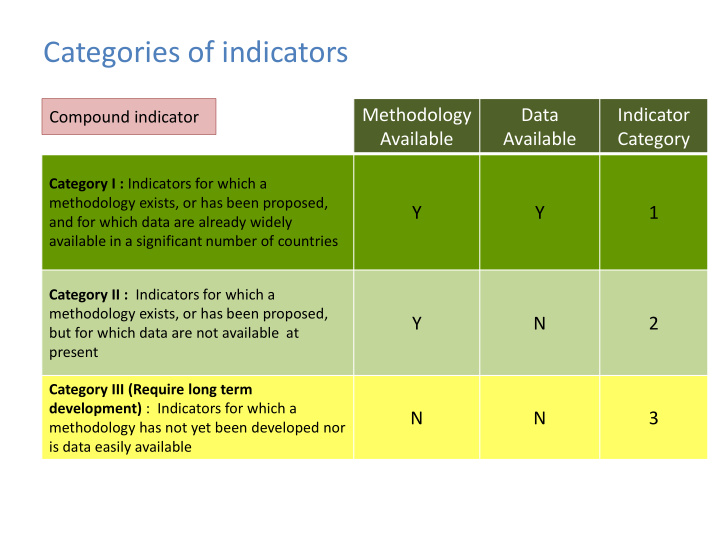



Categories of indicators Methodology Data Indicator Compound indicator Available Available Category Category I : Indicators for which a methodology exists, or has been proposed, Y Y 1 and for which data are already widely available in a significant number of countries Category II : Indicators for which a methodology exists, or has been proposed, Y N 2 but for which data are not available at present Category III (Require long term development) : Indicators for which a N N 3 methodology has not yet been developed nor is data easily available
Global Target (a) - Substantially reduce global disaster mortality by 2030, aiming to lower average per 100,000 global mortality between 2020-2030 compared to 2005-2015. A-1 Number of deaths and missing / presumed dead due to hazardous events (A-2 + A-3) per 100,000 A-2 Number of deaths due to hazardous events A-3 Number of missing persons / presumed dead due to hazardous events
Global Target (b) - Substantially reduce the number of affected people globally by 2030, aiming to lower the average global figure per 100,000 between 2020-2030 compared to 2005-2015. B-1 Number of affected people by hazardous event per 100,000. (B-2 to B-7) Number of injured or ill people due to hazardous events B-2 or Number of people suffering from physical injuries, trauma or cases of disease B2. alt requiring immediate medical assistance as a direct result of a hazardous events B-3a Number of evacuated people due to hazardous events B-3b Number of relocated people due to hazardous events B-4 Number of people whose houses were damaged due to hazardous events B-5 Number of people whose houses were destroyed due to hazardous events Number of people who received aid including food and non-food aid due to B-6 hazardous events Number of people whose livelihoods were disrupted, destroyed or lost due to B-7 hazardous events
Global Target (c) - Reduce direct disaster economic loss in relation to global gross domestic product (GDP) by 2030. C-1 Direct economic loss due to hazardous events in relation to global gross (C-2 to C-9) domestic product C-2 Direct agricultural loss due to hazardous events Direct economic loss due to industrial facilities damaged or destroyed by C-3 hazardous events Direct economic loss due to commercial facilities damaged or destroyed by C-4 hazardous events C-5 Direct economic loss due to houses damaged by hazardous events Damage and loss of administrative buildings C-5b C-6 Direct economic loss due to houses destroyed by hazardous events Direct economic loss due to damage to critical infrastructure caused by C-7 hazardous events Direct economic loss due to cultural heritage damaged or destroyed by C-8 hazardous events C-9 Direct economic loss due to environment degraded by hazardous events Total insured direct losses due to hazardous events C-10
Global Target (d) - Substantially reduce disaster damage to critical infrastructure and disruption of basic services , among them health and educational facilities, including through developing their resilience by 2030. D-1 Damage to critical infrastructure due to hazardous events (D-2 to D-#) Number of health facilities destroyed or damaged by hazardous events D-2 Number of educational facilities destroyed or damaged by hazardous events D-3 Number of transportation units and infrastructures destroyed or damaged by D-4 hazardous events D-4-b Kilometres of road destroyed or damaged per hazardous event. Number of bridges destroyed/damaged by hazardous event. D-4-c Kilometres of railway destroyed / damaged by hazardous event D-4-d Number of airports destroyed / damaged by hazardous event D-4-k Number of ports destroyed / damaged by hazardous event D-4-l Number of electricity plants / transmission lines destroyed or damaged by D-1 bis hazardous events Number of times basic services have been disrupted due to hazardous events D-5
Global Target (e) - Substantially increase the number of countries with national and local disaster risk reduction strategies by 2020. Number of countries that adopt and implement national DRR strategies in line with E-1 the Sendai Framework for Disaster Risk Reduction 2015-2030 Percentage of local governments that adopt and implement local DRR strategies in E-2 line with the Sendai Framework for Disaster Risk Reduction 2015-2030
Global Target (g) - Substantially increase the availability of and access to multi-hazard early warning systems and disaster risk information and assessments to the people by 2030. G-1 Number of countries that have multi-hazard early warning system G-2 Number of countries that have multi-hazard monitoring and forecasting system Number of people who are covered by and have access to multi-hazard early warning G-3 system per 100,000 Number of local governments having a preparedness plan (including EWS) or G-4 evacuation plan with standard operating procedures Number of local governments that have multi-hazard risk assessment / risk G-6 information, with results in an accessible, understandable and usable format for stakeholders and people Number of countries that have multi-hazard national risk assessment / information, G-5 with results in an accessible, understandable and usable format for stakeholders and people
Target Goal / Target A Number of deaths, missing persons and persons Goal 1. affected by disaster per 100,000 people Target 1.5 B Direct disaster economic loss in relation to global gross domestic product (GDP) C Goal 11. Direct disaster economic loss in relation to Target 11.5 global GDP, including disaster damage to critical D infrastructure and disruption of basic services Goal 11. Number of countries with national and local E Target 11.b disaster risk reduction strategies F Proportion of local governments that adopt and implement local disaster risk reduction strategies in Goal 13. line with the Sendai Framework for Disaster Risk Target 13.1 G Reduction 2015-2030
Recommend
More recommend